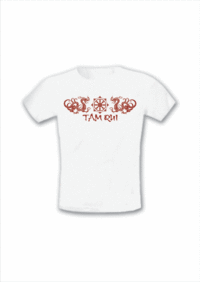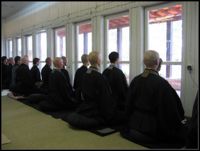Manjusri
From Buddha World
Manjusri is a bodhisattva (emanating enlightened being) in the Mahayana and Vajrayana traditions of Buddhism. Manjusri is the bodhisattva associated with wisdom, doctrine and awareness and in Vajrayana Buddhism is the meditational deity (yidam), who embodies enlightened wisdom. Historically, the Mahayana Buddhist scriptures assert that Manjusri was a disciple of Gautama Buddha, although he has no mention in Pali scriptures. The Sanskrit term Mañjuśrī can be translated as "Gentle Glory". Mañjuśrī is also known by the fuller Sanskrit name of Mañjuśrī-kumāra-bhūta.
In the Buddhist tradition
Manjusri is first referred to in early Mahāyāna texts such as the Prajñā-pāramitā Sūtras and through this association very early in the tradition he came to symbolize the embodiment of prajñā (wisdom). Manjusri later figures extensively in many texts associated with Tantric Buddhism such as the Mañjuśrī-mūla-kalpa and the Mañjuśrīnāmasaṃgīti. Together with the Buddha and fellow disciple Samantabhadra he forms the Shakyamuni trinity (Jp: Sanzon Shaka). In Tibetan Buddhism he sometimes is depicted in a trinity with Avalokitesvara and Vajrapani. Manjusri is mentioned in a number of Mahayana Buddhist sutras, particularly the Prajnaparamita Sutras. The Lotus Sutra assigns him a paradise called Vimala, which according to the Avatamsaka Sutra is located in the east. His consort in some Vajrayana traditions is Saraswati. He is also sometimes called Manjughosha. Within Tibetan Buddhism, Manjusri is a tantric meditational deity or Yidam, and considered a fully enlightened Buddha. In the Shingon school of esoteric Buddhism, he is one of the thirteen deities to whom disciples devote themselves. Manjusri leads the dragon king's daughter to enlightenment in the Lotus Sutra and he gives the second to last summation on emptiness in the Vimalakirti sutra. Tsongkhapa who founded the Gelug sect of tibetan buddhism received his teachings from visions of Manjusri. He is one of the four great bodhisattvas of Chinese buddhism, the four being: Ksitigarbha, Manjusri, Avalokiteshvara, and Samantabhadra. When he attains buddhahood his name will be Universal Sight. His pure land will be one of the two best pure lands in all of existence in all the past, present and future. Manjusri says in the "Manjusri Speaks on the Inconceivable State of Buddhahood" sutra that if Shakyamuni has attained buddhahood then he [Manjusri] has attained buddhahood. He is a dharmakaya bodhisattva, which means that unlike an ordinary 10th stage bodhisattva who still has a bit further to go before full enlightenment is attained, Manjusri has no further to go and can attain buddhahood at any time but has yet to achieve buddhahood because his vows are not yet fulfilled. It says in a sutra on Manjusri's attainment of Buddhahood that the benefits gained by keeping Manjusri's name in mind are superior to the benefits gained by keeping in mind the names of billions of Buddhas. This sutra can be found in "A Treasury of Mahayana Sutras".
Manjusri mantra
Chanting the Manjusri mantra:
- Om A Ra Pa Cha Na Dhīh
is believed to enhance wisdom and improve one's skills in debating, memory, writing, explaining etc. "Dhih" is the seed syllable of the mantra and is chanted with greater emphasis.
In Japanese Shingon Buddhism, this mantra is transliterated and recited as:
- On a raha-shanō
Iconography
A male Bodhisattva, he is depicted wielding a flaming sword in his right hand, representing his realisation of wisdom which cuts through ignorance and wrong views. The scripture supported by the flower held in his left hand is the Prajnaparamita, representing his attainment of ultimate realisation and Enlightenment. Manjusri is frequently depicted in Chinese and Japanese traditions as riding on the back of a lion. Variations upon his traditional form as Manjusri include Guhya-Manjusri, Guhya-Manjuvajra, and Manjuswari, most of which are Tantric forms associated with Tibetan Buddhism. The two former appearances are generally accompanied by a shakti deity embracing the main figure, symbolising union of form and spirit, matter and energy.
In other Buddhist cultures
Manchu
According to a legend, Nurhaci, a military leader of the Jurchen tribes in Northeast China and founder of what became the Chinese imperial Qing Dynasty, believed himself to be a reincarnation of Manjusri. He therefore is said to have renamed his tribe the Manchu.
Role in Nepalese mythology
According to Swayambhu Purana, the Kathmandu Valley was once a lake. It is believed that Manjusri saw a lotus flower in the center of the lake and cut a gorge at Chovar to allow the lake to drain. The place where the lotus flower settled became Swayambhunath Stupa and the valley thus became habitable. The Newars of the Kathmandu Valley, who adhere to both Buddhism and Hinduism, revere him as the Bodhisattva of Wisdom.
In China
For Chinese Buddhists Wutai Shan, which also had strong associations for Taoists, was considered to be the earthly abode of Manjusri and one of the Four Sacred Mountains of Buddhism in China. Manjusri was said to bestow spectacular visionary experiences to those on selected mountain peaks and caves there. These made it a popular place of pilgrimage, but patriarchs including Linji and Yun-men declared the mountain off limits. Being in the North of China and revered, Mount Wutai was also associated with the Northern lineages of Zen. In some Taoist schools, Manjusri was said to be an ancient Taoist Immortal. Master Sheng-yen (1988: p.364) renders the 'Manjusri Sutra' or 'Prajna Sutra" spoken by Manjuśri as saying to:
- ...contemplate the five skandhas as originally empty and quiescent, non-arising, non-perishing, equal, without differentiation. Constantly thus practicing, day or night, whether sitting, walking, standing or lying down, finally one reaches an inconceivable state without any obstruction or form. This is the Samadhi of One Act.








 По-Русски
По-Русски
